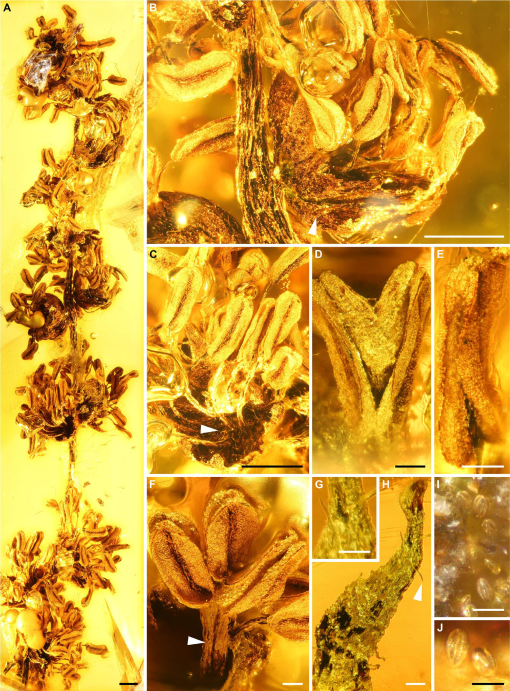Amber exquisitely preserves the delicate organs of fossil flowers for millions of years. However, flower inclusions can be rare and usually do not exceed 1 cm (0.4 inches) in size. Symplocos kowalewskii, an exceptionally large flower from Baltic amber, measures 2.8 cm (1.1 inches) across — about three times as large as most flower inclusions.

Symplocos kowalewskii. Scale bars – 1 cm. Image credit: Sadowski & Hofmann, doi: 10.1038/s41598-022-24549-z.
Amber preserves organisms three-dimensionally and with great fidelity, including arthropods, fungi, lichens, as well as minute inclusions of seed plants, such as leaves, flowers, catkins and pollen.
These inclusions are otherwise rare from the fossil record and therefore can yield new insights into ancient ecosystems ranging from the Triassic up to the Cenozoic.

Whereas inclusions of arthropods are most abundant, plant inclusions are generally rare.
Only 1-3% of all inclusions from Baltic amber are of botanical origin.

Although their exquisite preservation often allows assignment to genus or even species, most botanical amber inclusions are small in size.
For example, inclusions of flowers from Baltic amber mostly range between a few millimeters and about 1.5 cm (0.6 inches) in size.
Symplocos kowalewskii, which is 2.8 cm in diameter, is the by far largest flower inclusion known.

The specimen is dated to the Late Eocene epoch, at least 34 million years ago, and is thought to be from a flowering evergreen plant.
It was described over 150 years ago as Stewartia kowalewskii and has never been revised.
In a new study, Dr. Eva-Maria Sadowski from the Leibniz Institute for Evolution and Biodiversity Science’s Museum für Naturkunde and Dr. Christa-Charlotte Hofmann from the University of Vienna’s Institut für Paläontologie aimed to redescribe the exceptionally large flower.

They extracted pollen from the specimen and their analysis suggests that the flower is closely related to the Asian species of Symplocos.
The rare size of Symplocos kowalewskii is likely from a large resin outpouring which would have encased the flower.
The properties of the resin would have helped to prevent organisms growing on the flower and causing damage.

“The large size of the corolla and its basal fusion to a staminate ring likely indicates entomophilous pollination, as is known for some Asian Symplocaceae,” the authors said.
“Symplocos kowalewskii was likely a constituent of mixed-angiosperm-conifer forests in the Baltic amber source area and supports its affinities to evergreen broadleaved and mixed mesophytic forests of present-day East and Southeast Asia.”
Source: sci.news








